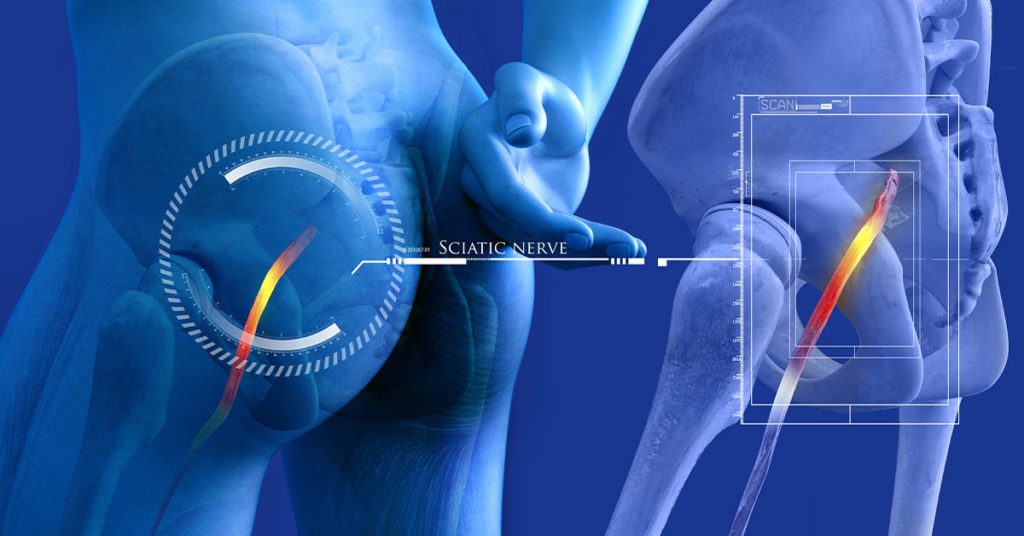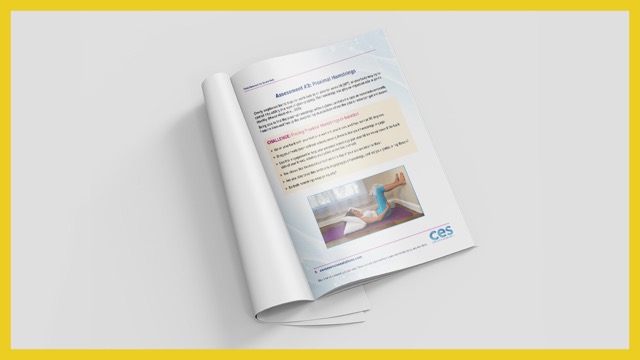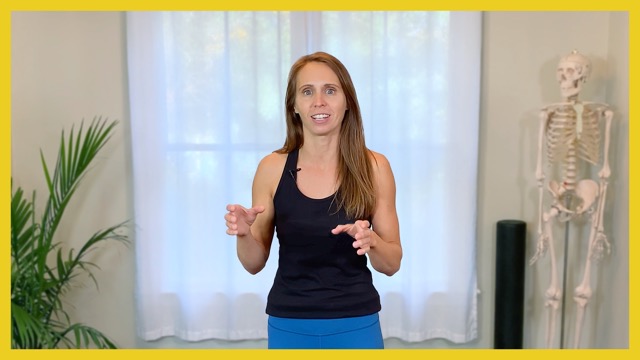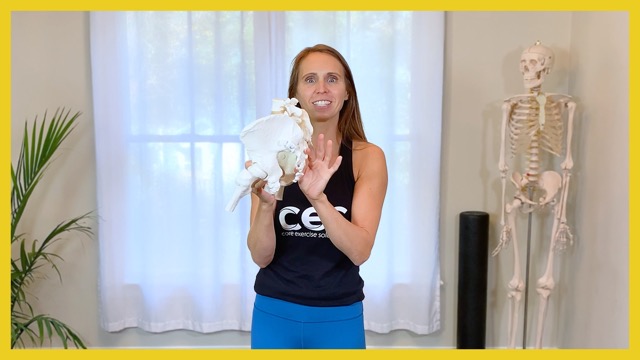Sciatic nerve pain is a global term that is often used when people complain of pain that runs along the path of this nerve, often identified as gluteus maximus pain. The sciatic nerve originates from nerves out of the lower lumbar vertebra, and it runs underneath the piriformis muscle and down the entire back side of the leg into the calf.
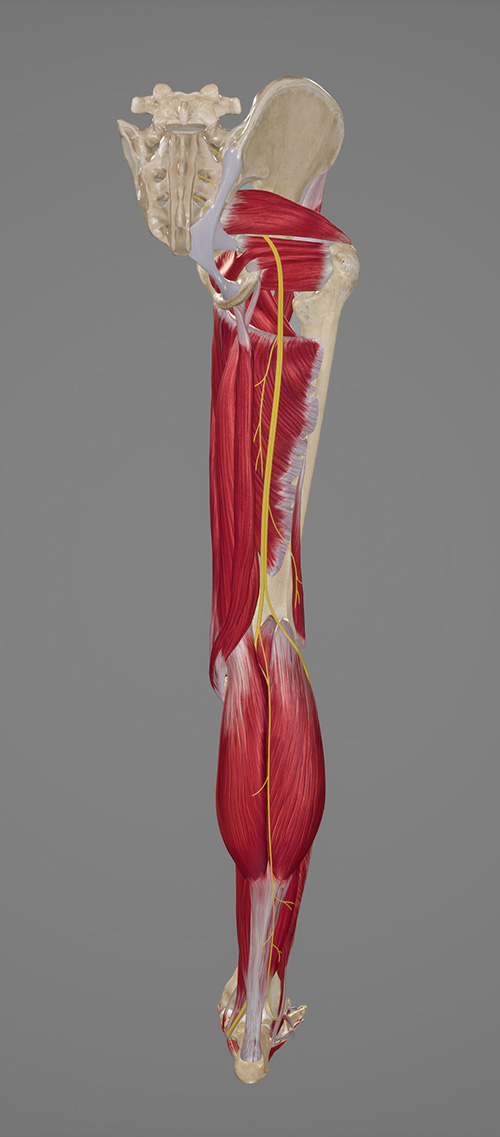
This pain can vary from shocking to mild cramping or a feeling of tightness, or numbness, tingling, and even weakness to the muscles and areas it innervates. Symptoms are due to nerve irritation anywhere along its path, which can be caused by issues like a herniated disc in the lower lumbar spine, a tight and overworked piriformis, or a weak gluteus maximus. So, if you’re looking for glute max pain relief, keep reading!
Does Clenching the Glutes Cause Low Back and Sciatic Pain?
Glute clenching is not a purposeful engagement of the glutes, but is what happens when you’re constantly holding tension in your glute muscles. Think of it like jaw clenching. We want our jaw to be able to close, but we don’t want to keep constant tension in the closing muscles all day long. This contributes to further pain and affects function.
Weakness or pain can cause a person to clench or squeeze their glutes all the time, using stiffness for stability or to help avoid painful movement. This can be a “pencil between the butt cheeks” clench, tucking into a constant posterior pelvic tilt, or both! Either way, holding your glutes clenched is bad because it can affect hip muscle function and movement, causing further glute tightness and weakness and sciatic nerve pain. It can also lead to a tight and weak pelvic floor.
Clenching the buttocks can contribute to low back pain as well. When you clench your glutes in standing to tuck your pelvis under, this reduces the lordotic curve in your lower back (making you look like you have a flat butt)! This puts the lower lumbar spine into constant flexion which can potentially cause damage to the lumbar discs and irritate the sciatic nerve.
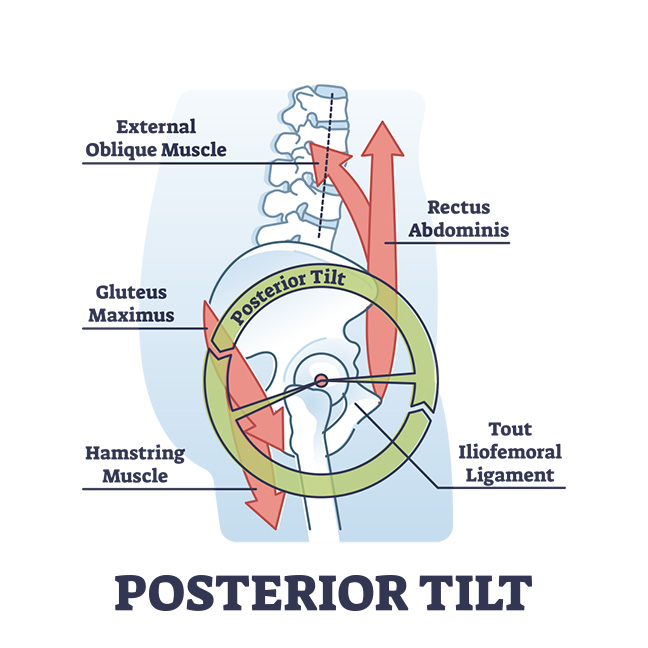
If the glutes are constantly clenched, then you can’t get relative movement in the back of the hips. With the back of the hips holding tight, the body will compensate by going into an anterior or posterior tilt as one unit rather than allowing movement between the individual parts of the pelvis (the ilium and the sacrum). This results in movement occurring in the lumbar spine instead of within the pelvis, which can potentially further irritate the low back and sciatic nerve.
How Do You Know if You Clench Your Glutes?
Sometimes glute clenching in standing can be subtle. While standing, squeeze your glutes and hold for one second, then completely let them go. Do you feel an increased relaxation of the muscle after actively engaging it? Do your glutes have a hard time letting go after squeezing? If you answered yes to either, then you most likely clench your glutes! Try this test while standing in the grocery line, brushing your teeth, or washing dishes at the sink. Catch yourself in mid-act, and stop clenching your buttocks.
Assessing if you are able to dynamically lengthen through your glutes with daily activities and then working on glute strength can help you stop clenching, and stopping the clenching can provide relief from glute max and low back pain.
Now that you’ve built awareness about glute clenching in standing, keep reading for more tips and exercises to help stop glute clenching in movement.
Can a Tight Gluteus Maximus Cause Sciatica?
If you’ve been clenching your glutes for a long time, this can contribute to tightness in the gluteus maximus that needs to be addressed first to decrease sciatic pain. Because the sciatic nerve runs underneath the back side glute muscles, tightness in the piriformis or gluteus maximus can cause sciatica.
Most of the time, this is not an issue that responds to stretching in the long term. You can stretch your piriformis or glutes and get a little relief for a short while, but then the pain comes back and you want to stretch again. The cycle of stretching for relief is just that, a cycle.
By strengthening the glutes through their full range, you will provide relief by lengthening the muscles in the back of your pelvis as the glute muscles get stronger. This will help you stop clenching your glutes and unload the deep hip rotators (like the piriformis) so they won’t have to overwork for the glute muscles. All of this can decrease the constant tension on the sciatic nerve and help with back pain.
Does Strengthening the Glutes Help Sciatica?
When the glutes are not able to dynamically do their job, they can get tight, and other muscles try to pick up the slack for them. This can contribute to making smaller muscles like the piriformis overwork and put pressure on the sciatic nerve. If you look at the size of the piriformis compared to the gluteus maximus in particular, you can see that it’s not built to do the job of the bigger muscles.
Improving the strength and function of the glute muscle complex (gluteus maximus, medius, and minimus) can provide sciatic and low back pain relief. But not all glute strengthening is created equal! It’s not just about more clamshells and birddogs or squeezing your butt at end range. You’ll also learn that we need to set the stage for your glute muscles to function well.
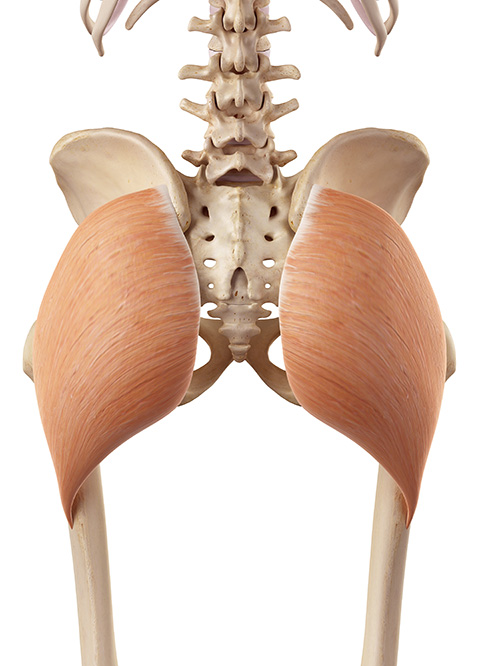
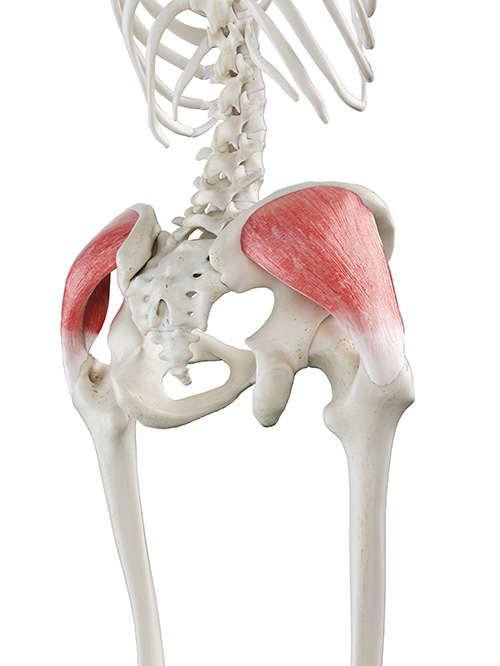
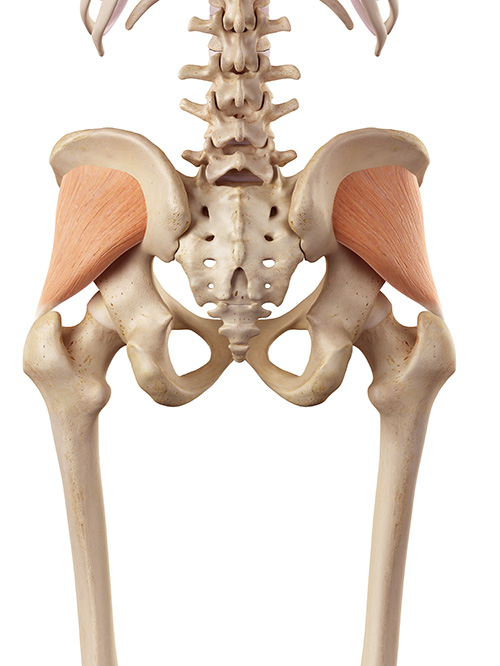
When performing glute exercises for sciatic pain, it’s about making sure you’re working the glute max through its full range of motion and ensuring that your glute muscles are set up for success.
Eccentrically Lengthening the Gluteus Maximus
Going back to the jaw analogy, the constant clenching not only contributes to muscles being overworked, but if you’re constantly clenching your jaw, it’s going to be hard to open your mouth. It’s not easy to squeeze a muscle tighter when it’s already shortened.
The gluteus maximus is a very large muscle that makes up the back side of the buttock. It concentrically performs external rotation and hip extension, and eccentrically controls hip flexion and internal rotation. Teaching the glute max how to eccentrically lengthen helps address glute tightness and also gives it a position to then shorten back from. This helps make sure you’re loading your glutes and not your back.
Eccentric loading means controlled lengthening. Try it on your biceps. Curl your arm up, and place two fingers side by side on the muscle. As you straighten your arm, your fingers should get further apart. You just witnessed lengthening of a muscle! To properly lengthen your glutes, place two fingers on the muscle. As you squat or hinge, your fingers should get further apart with a controlled letting go of your glute max. Think, “What you lengthen is what you load.”
Are your glutes initiating your squat, or is your back?
If you hold your glutes clenched, you’ll get the movement from somewhere else instead, overly lengthening one area to make up for another area that is not lengthening. This affects the distribution of load and potentially sets you up for injury in other areas, like your lower back.
Does your back hurt when you hip hinge?
Did you pass the test, or did your fingers stay the same distance apart? Even paying attention to common low level tasks like brushing your teeth, washing your hands, loading the dishwasher, or picking up things off of the floor can really add up, one way or the other. It's these little everyday tasks where the gluteus maximus says, "No thanks, I'll take a break and just clench at this low level instead of eccentrically loading (lengthening) to support the pelvis and spine like I'm supposed to."
Exercises for Sciatica Pain
Free PDF Guide: Glute Exercises for Sciatic Pain
Let’s continue exploring how to further address glute tightness and strengthening to help stop glute clenching for sciatic pain relief.
Calming Down the Deep Hip Rotators
Due to the sciatic nerve running under the piriformis, getting the deep rotators to let go is an important first step in addressing sciatic pain. Some of this can come in the form of stretching, and we can also make sure the muscles aren’t doing more than what they were built to do.
Releasing Tight Butt Muscles for Sciatic Pain Relief
If you are stretching, it can be more productive to think about not just lengthening the posterior hip muscles, but also improving the femur position. This can look like facilitating a posterior glide of the femur in the socket to address the true area of restriction.
Having a hard time opening up the back of your hips?
If your symptoms feel worse with stretching, it might mean that you actually need to strengthen your piriformis to help provide more stability to your hips. One way to do this while keeping the back of the hips more open to target more piriformis over obturator internus (another deep hip rotator) is by working internal rotation with the hips at 90 degrees of flexion. (Neumann, 2010) This is a movement that can be helpful for strengthening your adductors and anterior glute med to help with pelvic stability.
Calming down deep hip rotators
Strengthening the Glute Medius
Another step in getting the deep hip rotators to let go is making sure your gluteus medius is able to show up. Along with the adductors and core, the glute med is an important muscle to help provide pelvic stability to set the glute max up for success and stop clenching.
The gluteus medius has three different fibers, each with a different role. The anterior portion does internal rotation, the medial does abduction, and the posterior does external rotation. If you tend to be a “squeeze a pencil between your butt cheeks” type of person, oftentimes the anterior and medial are weaker. This is where being intentional with the glute work you do and the purpose behind it can go a long way. For example, assessing the ability to abduct without externally rotating can help bring balance to the glute med muscles and once again help avoid overusing those deep hip rotators.
Finding the glute medius
Addressing Pelvic Positioning
Another way your overachieving piriformis can try to do the job of your gluteus medius is when your pelvis is in an anterior tilt. This position aligns the fibers of the piriformis in a more optimal position than the gluteus medius to stabilize the pelvis.
Overly lengthened hamstrings can contribute to an anterior pelvic tilt, or your body may try to control it by adding in a layer of glute gripping. They also play an important role in pelvic stability (Massé-Alarie et al., 2015). So, whether it’s addressing the anterior pelvic tilt to help set the glute med up for success or to avoid gripping the glutes, addressing pelvic positioning by finding the proximal hamstrings without glutes or hip flexors can be an important step in calming down your piriformis and relieving your sciatic nerve pain.
Getting hamstrings without glutes to unstick the sacrum
Glute Exercises for Sciatic Pain
Free PDF Guide
📑 PDF Guide | 🕓 17 Pages
Address sciatic pain by improving glute activation, pelvic positioning, and hip stability.
Work the Gluteus Maximus
We have already talked about how important it is for the glute max to lengthen properly in the sagittal plane to support the pelvis and low back. Now let’s talk about it in different planes of motion, with a bit more support, and through its full range of motion in all directions.
Working just the eccentric lengthening into internal rotation can help get the piriformis to let go and set up for better sagittal plane work with squats, hip hinges, and lunges.
Sometimes the back side of the hip needs a bit more support to let go and lengthen. This is where adding in some adduction isometric work with eccentric lengthening of the glute max in the sagittal plane can be helpful. This allows us to open up the back of the hips but continue working in hip extension on the concentric portion to get more glute max than deep hip rotators. (Hodges et al., 2014) For this, try squeezing a block between your knees as you do your squats or bridges.
Sometimes you might need to switch up your approach. This might mean getting more help from the other leg to sit back into your glutes and provide extra stability for your pelvis.
Going backward to go forward
As you start to feel better, it’s important to take the hips through their full range when doing glute exercises for sciatic pain relief.
5 advanced exercises to add more rotation
Getting Rid of Sciatica Pain Permanently
If you really want to get rid of your sciatica pain permanently, it’s about a multi-pronged approach. In this case, it includes rewiring habits and patterns like glute clenching, unloading the deep hip rotators to help address glute tightness, and strengthening other parts of the hip complex to help your symptoms not return.
If you feel like you’re struggling with your glute work or are still having pain despite improving glute strength, it might be time to check in with other areas such as feet and abs.
Are your arches caving in? Do you collapse or over-pronate when you stand or walk? Your glute max could be desperately trying to compensate for your weak foot. Poor gluteus! The clenching is trying to say "Hey foot, wake up and hold my leg up, I can't do all the work from up here." For more information about foot strengthening, check out this article.
A strong core helps stabilize the pelvis to help the glutes not grip, with research even showing that core engagement increases glute activation. (Chan et al., 2017)
Abdominal progression
Along these same lines, good scapular muscle strength and positioning can also help support the spine and pelvis. This can include the serratus, which can help with core strength and stability, or the latissimus dorsi that invests into the thoracolumbar fascia to provide pelvic stability.
Use your serratus to help your hips
If this all seems like a lot, you can simply begin by trying to be more conscious of clenching your glutes. Start with a small task, like washing your hands. Every time you wash your hands, focus on letting your glutes lengthen instead of holding them tight.
During the day, give yourself the clench test. Bringing awareness to the area will help you overcome the habit of constantly holding them tight. By letting go a little, you will allow your body to get stronger naturally! And then with further strengthening, you will no longer be clenching your glutes and you’ll have more dynamic control and freedom of movement.
Interested in learning more? Check out our
Free PDF Guide: Glute Exercises for Sciatic Pain
Free Video Series: Pelvis Pro Foundations - Hips, Hamstrings & Rotation
Research:
- Neumann DA. Kinesiology of the hip: a focus on muscular actions. J Orthop Sports Phys Ther. 2010;40:82-94.
- Massé-Alarie H, Beaulieu LD, Preuss R, Schneider C. Task-specificity of bilateral anticipatory activation of the deep abdominal muscles in healthy and chronic low back pain populations. Gait Posture. 2015;41(2):440-447.
- Hodges PW, McLean L, Hodder J. Insight into the function of the obturator internus muscle in humans: observations with development and validation of an electromyography recording technique. J Electromyogr Kinesiol. 2014;24(4):489-496.
- Chan MK, Chow KW, Lai AY, Mak NK, Sze JC, Tsang SM. The effects of therapeutic hip exercise with abdominal core activation on recruitment of the hip muscles. BMC Musculoskelet Disord. 2017;18(1):313.
Free Pelvis Webinar (Professionals)
Understanding Deep Hip Rotator Tightness
🎥 1 Video Lesson | 🕓 47 Min
Identify gripping patterns, explore proximal hamstring activation, and try practical exercises for mobility and control.
Assess & correct deep hip rotator tightness with targeted tests, hamstring activation, and advanced hip control drills to reduce guarding and improve full hip motion.
Pelvis Pro Foundations Course (Professionals)
Hip Flexor and Posterior Tightness and Hamstring Activation
🎥 4 Video Lessons | 🕓 86 Min | 📑 PDF Downloads
Visualize biomechanics of the hip and pelvis.
A mini deep dive into hip tightness, hamstring dominance, deep rotator gripping, and how to reset movement patterns to improve pelvic control and relieve common hip pain triggers.

